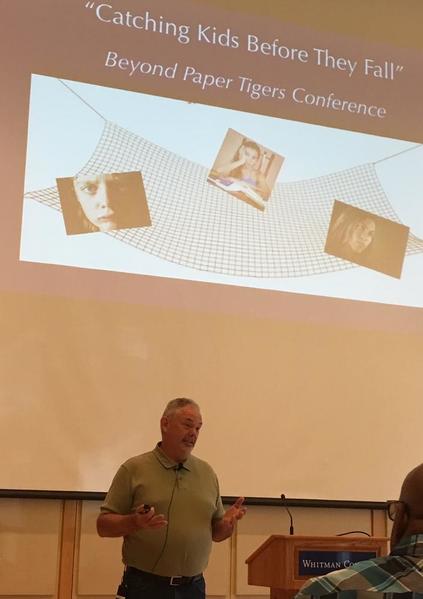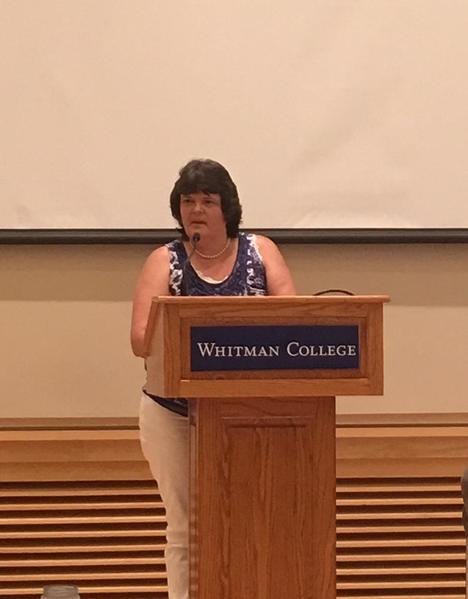Graphic artist Anne Nelson created this visual roadmap during the partner showcase, capturing the "heart of the matter" for each community member
Teri Barila, co-founder and CEO of the Children’s Resilience Initiative and the igniting force that brought change to a quiet corner of southeast Washington, kicked off last month’s Beyond Paper Tigers Conference by sharing one of her “aha” moments. In 2007, she attended a conference in Winthrop, WA, where Dr. Robert Anda spoke about the CDC-Kaiser Permanente Adverse Childhood Experiences (ACE) Study. It wasn’t the first time she’d heard about the ACE Study, but hearing about it this time affected her differently.
Anda was frustrated, he said: “The movement isn’t going anywhere.” His call to action: Every community in the U.S. needs to get involved, because the federal government wasn’t doing anything.
Barila recalled: “This time around, it hit my heart.”
Fast-forward nine years, and more than 200 people from Washington, Oregon, Texas, Tennessee and California gathered in Walla Walla to talk about what’s next for their communities after Paper Tigers, a documentary about how Lincoln High School in Walla Walla transformed the lives of students, school staff, and the community. The film has been shown in hundreds of cities and towns across the United States; tens of thousands of people have been touched by its message.
A screening of Paper Tigers for conference attendees was no different. There was hardly a dry eye in the room when the credits began to roll. Local leaders who appeared in the film were in the audience, including former Lincoln High School Principal Jim Sporleder and Intervention Specialist Brooke Bouchey. After the screening, Sporleder and Bouchey answered questions from the eager audience and offered words of encouragement and wisdom for other educators and providers in the room.
“How did you do this?” someone asked. “What curriculum or tool did you use to train your staff?” Although there’s definitely training involved, Bouchey was quick to note that being trauma-informed “isn’t about a curriculum or a textbook. It’s about shifting your perspective.”
Sporleder added that not everyone was on board at first, but noted that staff at Lincoln High School became more “relationship oriented,” and a change in perspective was a natural result of that. He also said that becoming trauma-informed “is a journey, not a foot race.” It will take time. There will be bumps in the road. “It is irresponsible for us not to move in this direction,” he said. “The research is just too strong.”
He elaborated on those thoughts during his keynote presentation, Catching Kids Before They Fall, which kicked off the conference. Barila introduced him as “one of the most compassionate people on the planet,” while cultivating the expectation of accountability from his students. Sporleder used his soft-spoken nature, experience, and sense of humor to share his thoughts on the education system, and where it needs to go. His overall message was clear: Our traditional approach to teaching and disciplining kids is not working.

Jim Sporleder kicks off Beyond Paper Tigers
“Kids aren’t getting better using our current approach,” he said.
According to Sporleder, the No. 1 problem in education today is that those most in control of influencing education policy at state and national levels lack knowledge of ACEs science and the trauma-informed framework. Our traditional approach to education is based on “punishment and rewards, which doesn’t work with kids who are operating with stressed brains,” he said.
Sporleder also spoke of standardized testing procedures and policy, which does not support alternative high schools or accommodate students who have experienced a high level of ACEs, as many Lincoln High School students have.
“We must change our approach,” he said. “Once kids connect with us and they begin to engage, test scores will go up. But first, we have to move away from the attitudes and beliefs that their behavior is something they are doing to us.”
During the conference, organizers Sporleder, Bouchey, Barila, and Rick Griffin, executive director of Jubilee Leadership Academy, a trauma-informed residential school in Prescott, WA, provided a wide array of sessions for participants. These include implementation strategies for administrators and other professionals; information on ACEs brain science and why it matters; triggers, understanding emotions and regulation; the generational impact of ACEs; and understanding behavior through a trauma lens.
Each presenter shared examples with participants of how they have incorporated this “shift in perspective” into their personal lives, leaving participants with the notion that this is an approach that you can apply to any relationship, anywhere, anytime.
During a break-out session on the power of regulation, Bouchey talked about the importance of learning to notice others, not judge them, and how this is an important first step toward shifting perspective.
“When we judge others, we tell them who we think they should be,” she said. Learning to notice others “is about unconditional love, which is the underlying result of acceptance.”
She also introduced the concepts of “growth mindset” (I can do anything I want to) vs. “fixed mindset” (I’m either good at it, or I’m not). We want to foster growth mindsets in our kids, help them persevere when frustrated and empower them to understand that their efforts and attitudes determine everything, Bouchey explained. She said that she’s applied these same principles to her own children, and that this has changed conversations she has with them from focusing less on achievements and ability, and more on their efforts and confronting and capitalizing on mistakes.
During his session on practical strategies for professionals, Griffin invited participants to “stay true to the model, which is relationship-based.” He also encouraged the group to begin to practice these concepts in our own families, as “it is where we have the greatest influence.” He shared strategies for creating a structure for safe classrooms, homes, or other spaces for kids, which include five stations:
- Preservation Station – Where can kids go to feel safe?
- Expectation Station – What are the guidelines and how these are communicated?
- Restoration Station – How do we come together when expectations are not met; how do we say, “I’m sorry?”
- Celebration Station – How do we celebrate their successes?
- Consideration Station – How and where do we share our feelings towards others?
Griffin believes every school needs a preservation room – a place kids can go to feel safe. Many educators in the room related how their schools provided safe places and experiences, including calming chairs, Lego and coloring stations, and providing kids with laminated cards with simple steps they can follow when they are feeling unsafe.
Conference participants also attended a screening of Resilience: The Biology of Stress and the Science of Hope, producer/director James Redford’s follow-up to Paper Tigers. It tells the story of how ACE Study was developed, and visits programs in California and Connecticut to demonstrate how they use ACEs science to improve services for children, families, and communities.
The conference concluded with a partner showcase, featuring 14 representatives from around Walla Walla, each explaining how they implemented trauma-informed and resilience building practices into their personal and work lives. The showcase included parents, youth, and coaches, early childhood educators, a local high school teacher, a Whitman College professor, a child welfare supervisor, two local medical providers, a court appointed special advocate (CASA), a Walla Walla Police Department sergeant, and representatives of local businesses and non-profits.
When introducing each partner, Barila asked each to talk about how things are different now that they have infused ACEs science and resilience-building practices into their daily work. She also asked each sector to go deeper, on a personal level, asking each to identify “what is the heart of this work to you,” or “the heart of the matter.”
Yolanda Esquival explained how the Walla Walla Head Start program has implemented Head Start – Trauma Smart, a model designed to address complex trauma in children and their families. This has allowed local educators to focus on addressing social-emotional skills with children at a young age, and has also provided teachers and parents to learn about their own trauma, which helps them with implementing strategies for teaching these skills.

One of the most powerful testimonials came from Annett Bovent, whose journey began in 2008 when Barila encouraged her to attend a local conference where Anda was speaking about the ACE Study. During Anda’s presentation, “something happened,” said Bovent, who walked into the conference a very quiet and retiring person. After Anda finished, he invited questions. Bovent walked to the front of the audience, took the microphone from Anda and said that she had an ACE score of 10, and that she finally understood that the things that had happened in her life “are not my fault.”
Anda sometimes shows Bovent’s two-minute testimonial at conferences, and notes: “This is transcendence. This is why we do this work and how we interrupt the intergenerational transmission of ACEs.”
After a long struggle with housing, including a three-year stint living in an old RV, Bovent was finally able to buy a house after Barila told her about an interest-free loan program. When Bovent moved in, her son showed up on her doorstep with a laundry basket full of cleaning, bathroom, and kitchen supplies. With tears in her eyes, Bovent described how meaningful this was for her. It led her to create Hope Heals, a non-profit that provides care packages for people moving into permanent housing. With great pride, Bovent announced she has already helped over 300 families this year.
Barila said that one of the results of the resilience-building efforts in Walla Walla was that it and Whatcom County, which is in far northwest Washington, were chosen to participate in Mobilizing Action for Resilient Communities (MARC), a two-year, 14-community learning collaborative funded by the Robert Wood Johnson Foundation, and managed by The Health Federation of Philadelphia.
The conference’s grand finale was delivered by five youth from nearby Dayton School District. Led by youth coordinator Jennifer Price, the teens are part of Students Helping Each Other (SHEO). A few years ago, Barila provided training for the school district and the community. As a result, a few youth developed a presentation about ACEs and resilience. According to the students, at first school administrators didn’t understand, or support, their work. However, after the students organized two screenings of Paper Tigers -- one in the community, and the other in their high school -- their administration began supporting their efforts, and they have done presentations for other students, teachers, and administrators, as well as throughout the community.

Although the conference did not, and could not, as a whole, decide what happens “Beyond Paper Tigers”, this conference provided a vibrant and inspiring two-day opportunity for members of communities that have ACEs initiatives – or are thinking about establishing them -- to share and learn from one another. They discussed and exchanged challenges, ideas, resources, and strategies, and took those back to their own schools and communities to take the next steps in their own local movements.




Comments (3)